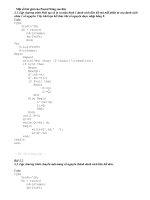Exponent _ Rules _ Math
Bạn đang xem bản rút gọn của tài liệu. Xem và tải ngay bản đầy đủ của tài liệu tại đây (103.95 KB, 16 trang )
Exponent Rules
a ×a = a
m
n
m +n
m
a
m −n
=a
n
a
0
a =1
(a )
m n
=a
mn
a
−m
1
= m
a
a negative exponent
"means" take the
reciprocal of the base
Exponent Rules
x ×x
3
x
3 +2
x
5
2
Exponent Rules
( −2 x y ) ( 3 xy )
( −2 ) ( 3) ( x x ) ( y
7
2
4
7
−6x y
8
6
2
y
4
)
Simplify each algebraic expression.
Do NOT leave negative exponents.
4
14m
9
−7 m
2g7gm m m m
−2
= 5
−1g7gm m m m m m m m m
m
Exponent Rules
( −3x y )
5
4
3
( −3 x y ) ( −3 x y ) ( −3 x y ) ( −3 x y )
5
3
5
20
81x y
3
12
5
3
5
3
Simplify the given expression.
Do not leave negative exponents.
5
−2
1
2
5
1
25
Simplify the given expression.
Do not leave negative exponents.
Clear outside exponents first,
move the “location” of the base that
has a negative exponent
the base still has an exponent, but now
it is positive.
Simplify the given expression.
Do not leave negative exponents.
y y
5 2
y y
2
−1
−2
y y
2 −1
y y
5
2
2
10
4
y y
4 −2
y y
14
y
12
=y
2
y
Simplify the given expression.
Do not leave negative exponents.
Clear outside exponents first, make sure
all parenthesis are “gone” before
“moving” bases.
The base is only what the exponent
touches.
Simplify the given expression.
Do not leave negative exponents.
2
x y
4 −3
x y
2
x yy
4
x
3
2
x y
4
x
4
4
y
2
x
Simplify each numerical expression.
a
−m
=
1
am
Negative exponent,
take the reciprocal
of the base
1
am = m a
Rational exponent,
rewrite as radical,
the denominator is
the index
n
am
=
m n
a
Rational exponent,
rewrite as radical, the
denominator is the
index, the numerator is
still the exponent of the
base.
Simplify each numerical expression.
25
1
− ÷
2
1
25
1
÷
2
1
25
1
5
Simplify each algebraic expression.
Do NOT leave negative exponents.
When working with rational exponents,
the denominator of the exponent is
the index of the radical, and the
numerator is still the exponent of the
base.
The base is only what the exponent
“touches”.
Simplify each algebraic expression.
Do NOT leave negative exponents.
a
a
1
÷
a 6
3
− ÷
4
2
÷
3
12
÷
÷
÷
a
( −9 )
a
a
( 2)
( 8)
1
a
3
Simplify each algebraic expression.
Do NOT leave negative exponents.
If n is a positive integer and m is any
integer and is a real number, then
m
an
(
= a1 / n
1
am n
) =( )
m
In radical notation:
m
an
=
( a)
n
m
n
= a
m
Simplify each algebraic expression.
Do NOT leave negative exponents.
1
4 −6 2 ÷
x y
−6 2 ÷
x y
1
6 12 − 3 ÷
x y
−9 ÷
z
x 2 y −3 x −2 y −4
−3 1 ÷
÷
3
x y z
⇒
x 0 y −7
x −3 y1 z 3
x3
y8 z 3









